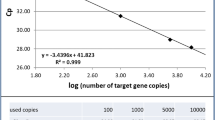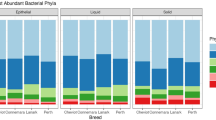Abstract
The aim of this study was to trace selected nucleic acid and protein components of isogene versus Bt transgene maize within the bovine gastrointestinal tract (GIT). After feeding 22 cattle for 4 weeks with Bt176 maize, different plant genes and the recombinant protein CryIAb were quantified during digestion. Furthermore, a first initial characterization of rumen bacteria was approached, using 16rDNA gene sequencing comparing isogene- against transgene-fed animals. Ingesta samples of different GIT sections (rumen, abomasum, jejunum, colon) were analysed for chloroplast, maize invertase, zein and Bt toxin (CryIAb) gene fragments using quantitative real-time PCR. First, the initial gene dose of these maize genes was detected in maize silage. During digestion, a significant reduction of high-to-medium abundant plant gene fragments was shown depending on the dwell-time and the initial gene copy number. Immunoreactive CryIAb protein was quantified by ELISA in intestinal samples indicating a significant loss of that protein. Remarkable amounts of Bt toxin were found in all contents of the GIT and the protein was still present in faeces. For the first time, the influence of CryIAb transgene maize on rumen bacterial microflora was investigated compared to isogene material through analysis of 497 individual bacterial 16S rDNA sequences. In principle, specific bacterial leader-species could be identified in all bovine rumen extracts, but no significant influence of Bt176 maize feed was found on the composition of the microbial population. This investigation provides supplementing data to further evaluate the fate of novel recombinant material originating from transgene feed or food within the mammalian GIT.




Similar content being viewed by others
References
van Duijn GJ, van Biert R, Bleeker-Marcelis H, van Boeijen I, Ada AJ, Jhakrie S, Hessing M (2002) JAOAC Int 85:787–791
Einspanier R, Klotz A, Kraft J, Aulrich K, Poser R, Schwägele F, Jahreis G, Flachowsky G (2001) Eur Food Res Technol 212:129–134
Klotz A, Mayer J, Einspanier R (2002) Eur Food Res Technol 214:271–275
Doerfler W, Schubbert R (1998) Wien Klin Wochenschr 110:40–44
Schubbert R, Renz D, Schmitz B, Doerfler W (1997) Proc Natl Acad Sci USA 94:961–966
Doerfler W, Schubbert R, Heller H, Kämmer C, Hilger-Eversheim K, Knoblauch M, Remus R (1997) Tibtech 15:297–301
Doerfler W (2000) Foreign DNA in mammalian systems. Wiley-VCH, Weinheim, New York
Anklam E, Gadani F, Heinze P, Pijnenburg H, Van Den Eede G (2002) Eur Food Res Technol 214:3–26
Vaitilingom M, Pijnenburg H, Gendre F, Brignon P (1999) J Agric Food Chem 47:5261–5266
Smith PK, Krohn RI, Hermanson GT, Mallia AK, Gartner FH, Provenzano MD, Fujimoto EK, Goeke NM, Olson BJ, Klenk DC (1985) Anal Biochem 150:76–85
Klaften M, WhetsellA, WebsterJ, GrewalR, Fedyk E, Einspanier R, Jennings J, Lirette R, Glenn K (2004) Development of PCR methods to detect plant DNA in animal tissue. In: Bhalgat MM, Ridley W P, Felsot A S, Seiber J N (eds) Agricultural biotechnology: challenges and prospects. ACS Symposium Series 866, American Chemical Society ,Washington D.C., pp 83–99
Bendich AJ (1987) BioEssays 6:279–282
Hupfer C, Meyer J, Hotzel H, Sachse K, Engel K-H (1999) Eur Food Res Technol 209:301–304
Chiter A, Forbes M, Blair GE (2000) FEBS Lett 481:164–168
Aumaitre A, Aulrich K, Chesson A, Flachowsky G, Piva G (2002) Livestock Prod Sci 74:223–238
Chowdhury EH, Shimada N, Murata H, Mikami O, Sultana P, Miyazaki S, Yoshioka M, Yamanaka N, Hirai N, Nakajima Y (2003) Vet Hum Toxicol 45:72–75
Ehlers B, Strauch E, Goltz M, Kubsch D, Wagner H, Maidhof H, Bendiek J, Appel B, Buhk H-J (1997) Bundesgesundheitsblatt 40:118–121
Studer E, Dahinden I, Lüthy J, Hübner P (1997) Mitt Geb Lebensmittelunters Hyg 88:515–524
Hupfer C, Hotzel H, Sachse K, Engel K-H (1998) Z Lebensm Unters Forsch A 206:203–207
Loy A, Lehner A, Lee N, Adamczyk J, Meier H, Ernst J, Schleifer KH, Wagner M (2002), Appl Environ Microbiol 68:5064–81
Acknowledgement
This study was supported by the BMBF project 01K0-31P2614. The authors gratefully acknowledge the skilful assistance and help of Stefanie Schiebe, Tamara Steltzl, Inge Celler (Freising), Rutzmoser and Steinberger (Grub).
Author information
Authors and Affiliations
Corresponding author
Rights and permissions
About this article
Cite this article
Einspanier, R., Lutz, B., Rief, S. et al. Tracing residual recombinant feed molecules during digestion and rumen bacterial diversity in cattle fed transgene maize. Eur Food Res Technol 218, 269–273 (2004). https://doi.org/10.1007/s00217-003-0842-9
Received:
Published:
Issue Date:
DOI: https://doi.org/10.1007/s00217-003-0842-9




